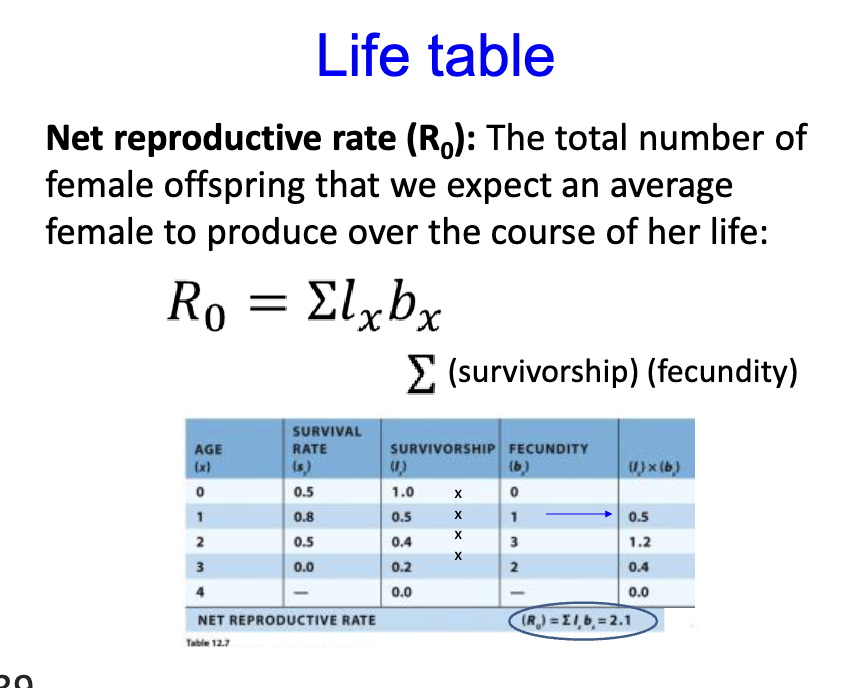9. Population Growth
1/36
There's no tags or description
Looks like no tags are added yet.
Name | Mastery | Learn | Test | Matching | Spaced |
|---|
No study sessions yet.
37 Terms
Population size def.
the humber of individuals of the same species living in a defined geographical area
Population sizes change equation
(Births - deaths) + (immigrants - emigrants)
population growth models
Geometric and exponential models describe population growth in an idealized environment with unlimited resources and good conditions
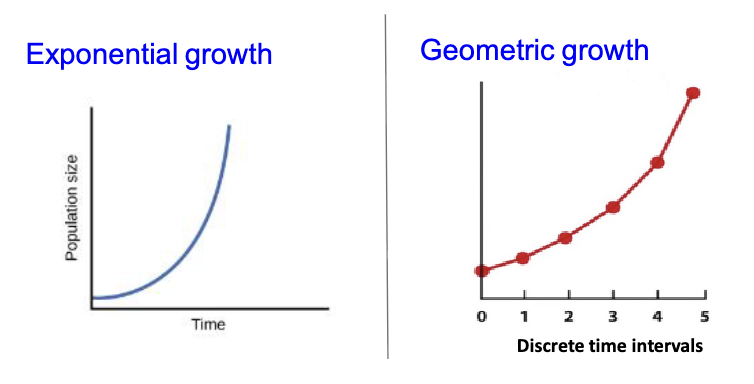
Carrying capacity
the max amount of individuals in a population due to limiting factors & resources
Population growth rate def.
the humber of new individuals that are produced per unit of time minus the number of individuals that die
births - deaths
Intrinsic growth rate ( r ) def.
the highest possible per capita growth rate for a population (max. reproductive rates and min. death rates
Closed population intrinsic growth rate ( r ) equation
r = b - d
r = birth rate - death rate
intrinsic growth rate ( r ) equation example
A population of 100 bats. In a year 80 are born and 60 die
b = 80 / 100 = 0.8
d = 60 / 100 = 0.6
r = 0.8 - 0.6 = 0.2
or
80-60 / 100 = 0.2
Exponential growth model def
A model of population growth in which the population increases continusouly at an expeoential rate; can be described by the equation Nt = Noe^rt
Nt = Noe^rt equation
Nt = future population size
No = Current population size
e = exponential constant 2.72
r - intrinsic growth rate
t - time over which a population grows
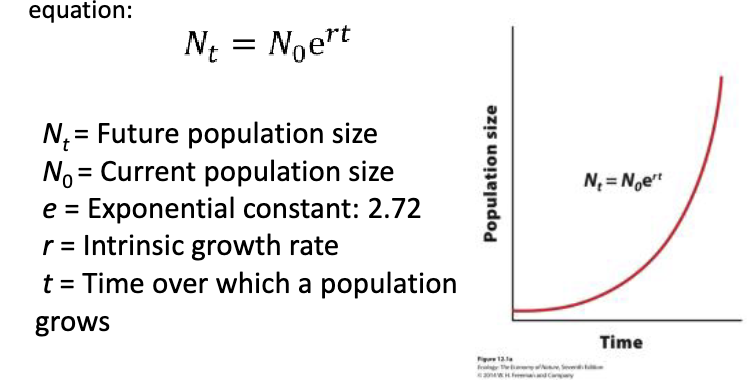
G = rN equation
G = number of individuals added during any time interval
r = intrinsic growth rate b - d
N = population size
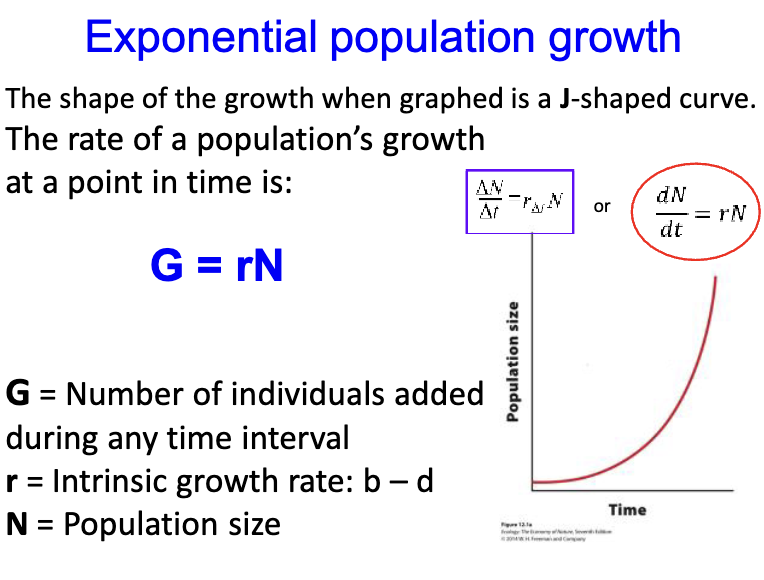
In exponential growth what is proportional
number of new individuals to size of population
Exponential growth example
we have 100 ladybugs with r = 0.22 per day. How many individuals will be added per day?
G = r x N
r = 0.22
N = 100
G = 0.22 × 100 = 22 individuals per day
New population size equation
N + G
G = number of individuals added during certain time interval
N = population size of the time interval
New population size equation example
0) 0.22 100 = 22 : 100 + 22 = 122
1) 0.22 122 = 26.84 : 122 + 26.84 = 149
2) 0.22* 149 = 32.78 : 149 + 32.78 = 182
3) 0.22* 182 = 40.04: 182 + 40.04 = 222
4) 0.22* 222 = 48.84: 222 + 48.84 = 271
5) 0.22* 271 = 59.62: 271 + 59.62 = 331
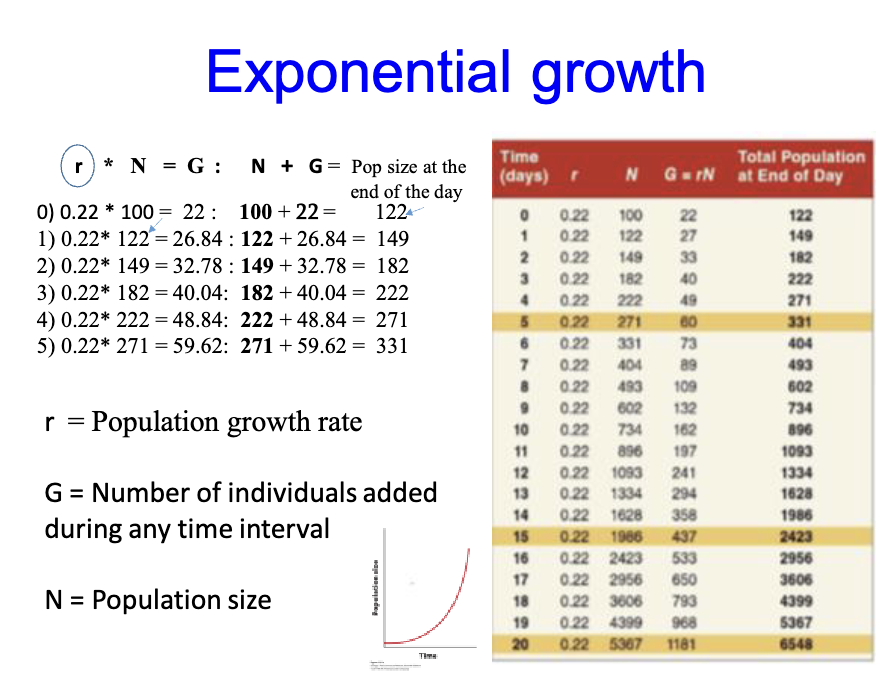
Geometric growth model
Discrete time intervals / breeding seasons
expressed as ratio of a population’s size in one year to its size in the preceding year λ
λ: N1/No, N2/Na, etc
λ cannot be negative
λ > 1 population size has increased
λ = 180 / 100 - 1.8
λ < 1 population size has decreased
λ = 80 / 100 = 0.8 (lower than 1)
Geometric growth model time intervals
The size of a population after one time interval is:
N1 = N0λ
After two time intervals, the population size would be:
N2 = (N0λ)λ = N0λ²
Or, more generally, after t time intervals
Nt = N0λ^t
Geometric growth model time intervals example
Start with a population of 100 individuals.
Annual growth rate λ = 1.5
After 5 years the size of the population is:
N5= N0 x λ5 = 100 x 1.55 = 759
1.5×1.5×1.5×1.5×1.5 = 7.59
Comparing growth models
Population decreasing λ < 1 and r < 0
Population constnat λ = 1 and r = 0
Population increase λ > 1 and r > 0
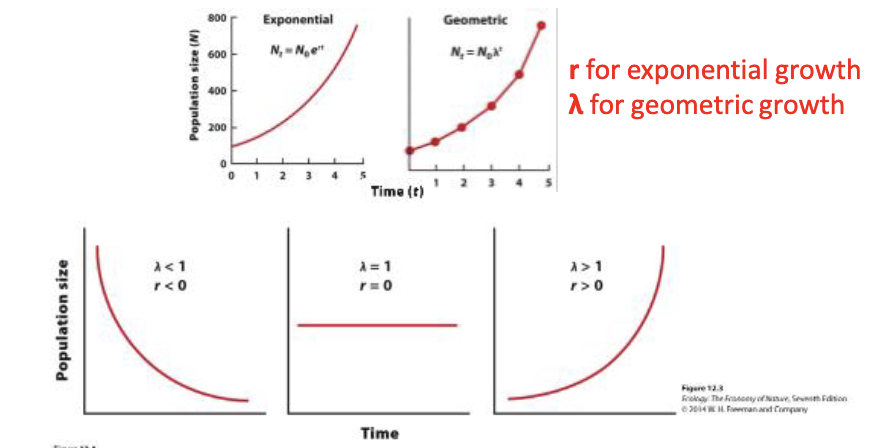
Density dependent controls def.
effects increase as population grows; intraspecfic competition, predation, parasitism, and infectious disease.
Higher population size = food supply diminishes, compettion increases
Higher denstiy = infectious diseases spread more easily
Higher density = Preadators are attracted
Desntiy depdednce in plants
Horseweed plants at a
density of 100,000 m2.
Over time, many individuals
died.
As density decreased, there
was a significant increase in
the weight of surviving
individuals

Postive density depdence def
rate of population growth can increase as popualtion desnity increases (allel effect)
postive ocrrelation between population density & indivdual fitness
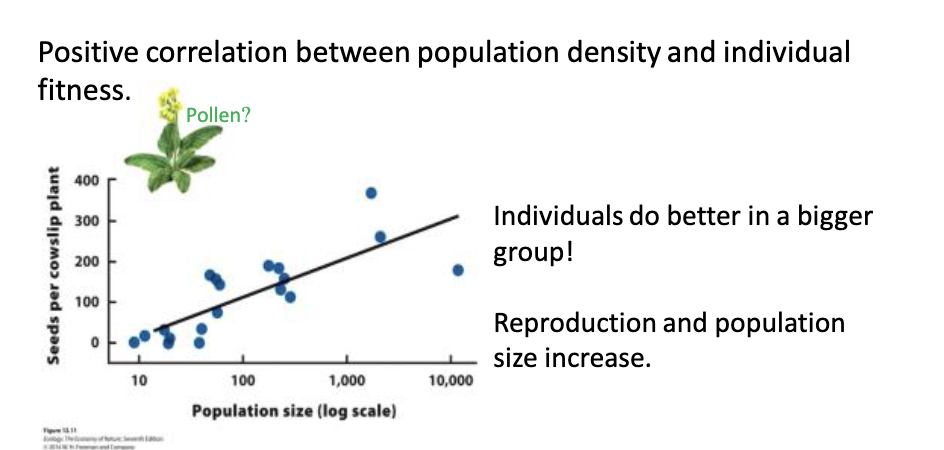
Density indepdent controls def.
Limit population size regardless of the population’s density
Cliamtic events (torandoes, floods, tempeatures, droguths, fire
birth and death rates do not change as density rises but sudeenly mortaitly rate increases and repodruvce rate decreases
Logistic growth model
The per captia rate of population growth approaches zero as the population size nears carrying capacity (K)
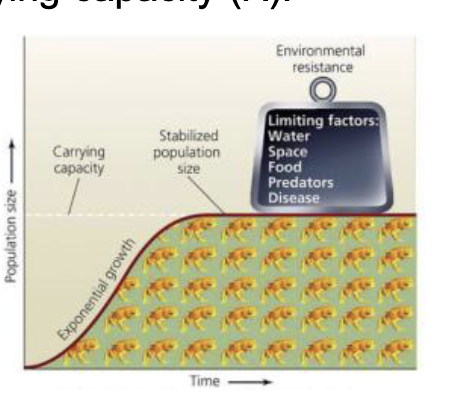
Logistc growth model requation
dN/dt = rN (1 - N/K)
G = rN (K-N/K)
G = number of individuals added per unit of time
r = growth rate
N = number of individuals in the population at a given time (population size)
K = carrying capacity
Carrying cacpacity (K) def
the maximum population size that can be supported by the envrioment
As population size increases
resoruce shortages
enviomrnetal limitations
withing-sepcies compettion
upper limit on population size
not fixed, can change
S-shaped curve def
shape of curve when a poplation is graphed over time using the logtistc growth model
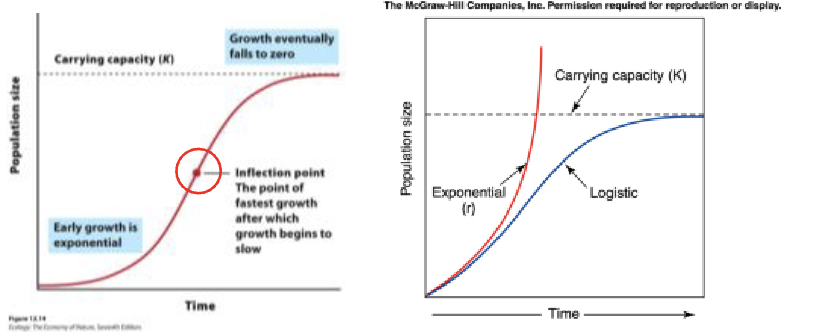
Inflection point def
the point on a sigmodial grwoth curve at which the population has its highest growth rate
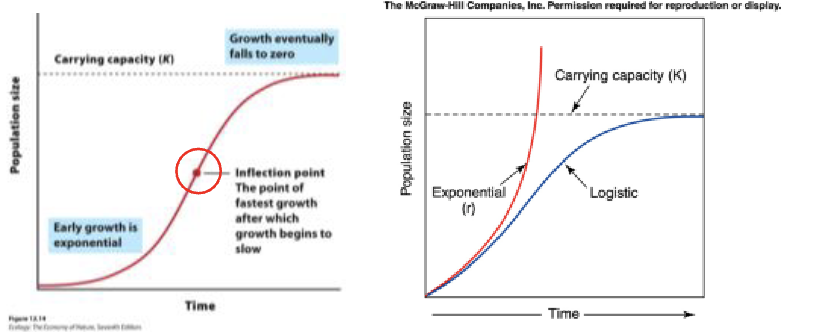
Two species of protists with a fixed amount of food each day.
Populations initially grew in size but eventually stabilized at
different carrying capacities depending on the available
resources.
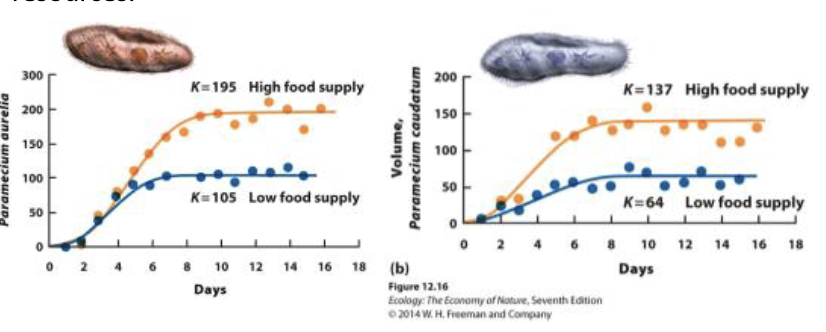
A mammalogist estimates that there are N1 =
10,000 mice living in a large section of forest,
which she estimates has a carrying capacity (K) of
100,000. The population appears to have an
intrinsic growth rate (r) = 0.05 mice / mouse / year
What do you predict for G during this next year?
a) 45 mice
b) 50 mice
c) 450 mice
d) 500 mice
e) 4500 mice
G = rN (K-N/K)
r - 0.05
N = 10,000
K = 100,000
G = (0.05)(10,000) (100,000 - 10,000) / 100,000)
G = 450 mice
Survivorship Curves
Type I: Low mortality early in life
Type II: Sontant mortality
Type III: High mortality early in life
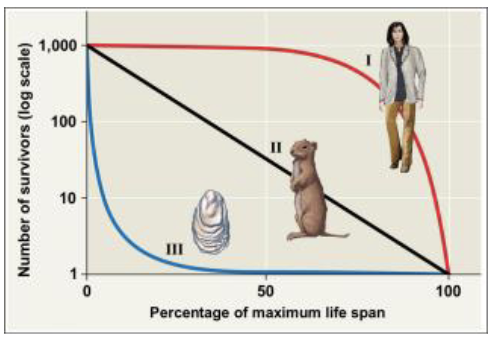
Age strucutre pyramids
broad bases: growing population
Narrow bases: declining poulation
Straight sides: stable population
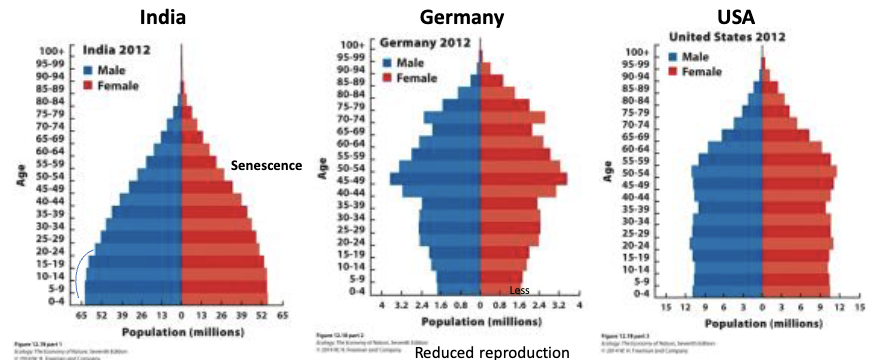
Life table
Contain class - specfic survival and fecusintiy data
based on the number of female offspring per female
x = age class
Nx = number of indivduals in each age
Sx = surival rate from one age
bx = the fecunigty of each age class (briths)
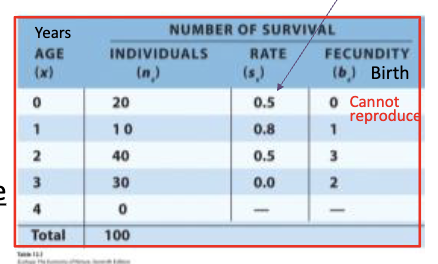
Life table calculations
Number surviving to next age class - nx x sx = 20 x - 0.5 = 10
Number of new off spring produced = nx x sx x bx = 10 × 0.5 × 1 = 10
λ: The number of individuals in a population after one time interval
divided by the initial number of individuals λ: N1/N0=112/100=1.12
Life table survivorship def
The probabilty of survving from birth to any later age class ( /x); surviorship in the first age class is always set at 1
example surviroship to the second year (I2) is calcuted as l2 = l1s1
Life table newt reporeucte rat R0 def.
the total number of female offspring that we expect an averate female to produce over the course of her life
R0 = total lxbx
total = surivierhip fecundity
